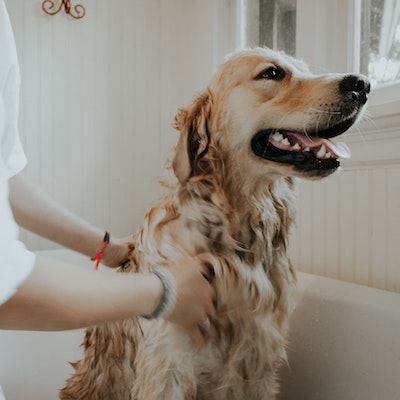
Clean up!
There are now many different types of them. They differ in size and price. They should also be suitable for different needs. So there is a large selection of dog shampoo for fur noses. Unfortunately, many of them have one thing in common. They are made from countless ingredients that are far too often unnecessary. For example surfactants. Of course, there are many more things you should consider with dog shampoo for fur noses and when washing.
You can find the answer here.
The largest organ of your fur nose – biology
Just like humans, the dog’s skin is the largest organ. A cross-section of your favorite’s skin: at the top is the top coat, then the lower coat and then the epidermis (the epidermis). This is followed by the dermis and subcutaneous fat.
With its complex nerve network, extremely fine blood vessels and glands, the skin has many central tasks. It protects against external environmental influences, the penetration of microorganisms, such as bacteria, and noxae (causes of illness), as well as the loss of the body’s own substances. It regulates blood pressure and is jointly responsible for regulating body temperature, regardless of the length and density of the coat. Dogs also notice temperature and air pressure fluctuations, pain and itching through the skin. Sebaceous and sweat glands are also distributed all over the body. And yes, despite the opinion of many that dogs cannot sweat, dogs can sweat. However, only where the merocrine glands are located. Namely on the paws. Everywhere else there are apocrine glands. These are not actively involved in the central heat regulation mechanism.
The skin is therefore an extremely important defense system.
The dog shampoo for fur noses
Dog shampoo, like everything else, should be tailored to the needs of your fur nose. In the past, baby shampoo was often used for dogs. However, the skin of dogs is very different from that of humans. Human skin has a natural skin pH of 5.5. The average pH of dog skin is 7.5. Depending on the dog breed. The skin flora of your fur nose is also different. Due to the fact that dog skin is significantly thinner, the shampoo penetrates the skin very differently. But that also has an advantage: it renews and regenerates much faster.
Dog shampoos with an incorrect pH value are very toxic for the protective skin flora of your fur nose.
The dog shampoo for fur noses should always have the correct pH value (6 – 8.7). So the dog’s acid protective coat is not attacked. If not necessary, you should make sure that the shampoo is free of perfumes and fragrances. Also pay attention to high-quality ingredients. That means: without silicones, without sulfates, without preservatives, without the addition of dyes and without palm oil.
There is also dog shampoo with special ingredients. For example, aloe vera moisturizes and has an anti-inflammatory effect, relieves itching and is ideal for dogs with sensitive skin. Aloe Vera strengthens wound healing and activates the immune system. Lavender protects the dog from parasites such as fleas and ticks, has antiseptic, anti-inflammatory and calming properties and also has a pleasant fragrance.
We also recommend that you only use dog shampoo that does not consist of palm oil. Why no palm oil? Palm oil is not toxic, but it does have a long rat tail. Rainforests are being destroyed. Instead, oil palms are planted to harvest palm oil. Aborigines are expelled, the climate is negatively affected and the habitat of rare animal species such as the orangutan, the Borneo dwarf elephant and the Sumatran tiger is destroyed. That’s why you should make sure that your own shampoo is free of palm oil.
Every year
Also statements like, you can wash the dog a maximum of once or twice a year, are simply wrong. The misconception comes from the time when no dog shampoo was known and was washed accordingly with human shampoo, which is harmful to dogs. Especially if your fur nose smells bad or dirty, you should wash him or her. Make sure that the surface is non-slip or use an anti-slip mat. Wash your fur nose with lukewarm water and start with your paws. Because, just like with humans, it can otherwise lead to circulatory problems. You should also make sure that no matter how mild the dog shampoo is, the shampoo will not come into contact with the eyes, nose, mouth or ears. Please do not blow dry your dog after bathing, because this dries out the skin. Thorough drying with a towel is sufficient and also promotes blood circulation.
It is best to get your fur nose used to bathing in puppy age.
In general, you can wash your fur nose regularly with the right dog shampoo, depending on your needs and dog breed. With skin problems such as itching, dry, oily or flaky skin and with allergies, regular bathing can be very useful. Here, however, you should consult your veterinarian or a specialist.
There are also conditioners for dogs. These are not absolutely necessary. However, they can make combing easier and additionally protect against dust and dirt.

